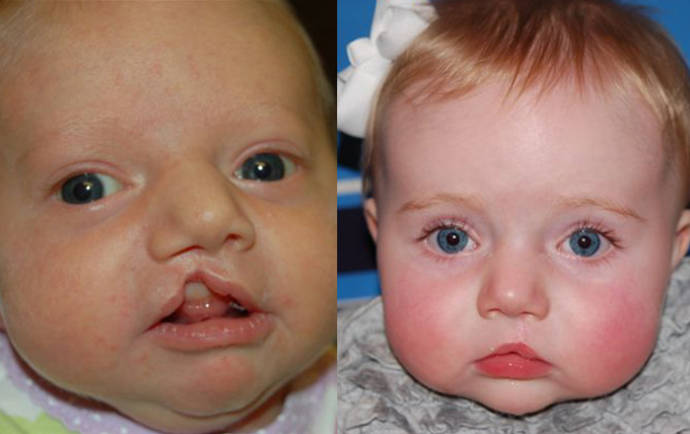Cleft lip and cleft palate are some of the most common birth defects observed in both male and female children. A baby might have a cleft lip or a cleft palate or both, right from his/her birth. These defects together are medically termed as “orofacial clefts”.
Cleft lip is more common than cleft palate and it affects one in 700 babies annually. Cleft lip with or without cleft palate has been observed to be more common amongst children of Asian, Native American and Latino descend. The occurrence of cleft lip, with or without cleft palate is more common amongst boys, compared to the girls. This birth defect might create oral as well as speech and psychological problems in a child as he/she grows up. However, the good thing is that both Cleft Lip and Cleft Palate can be repaired in babies, without leaving any surgery mark depending on the severity of the cleft. Before we get to the details of how the problem is treated, first let us take a deeper look into the problem.
What is cleft lip?
A cleft lip can be described as an opening at the side of the upper lip that might or might not extend till the base of the nose. During the fourth and seventh weeks of pregnancy, the central part of the face of the baby, including the nose and the lips are formed. The tissue and cells from both the sides of the head grow during pregnancy and within this time, the tissues fuse together at the middle, creating different facial features.
When due to some reasons these tissues from both the sides do not fuse completely at the middle and leaves an opening near the upper lip, a cleft lip is formed. The size of the opening can vary from a small slit to an extended opening. Normally, the cleft lip happens only at one side of the lip, but it can also occur at both the sides or at the middle of the upper lip. A child born with a cleft lip might or might not have a cleft palate.
What is cleft palate?
The roof of the mouth is called the palate and a cleft palate simply means an opening in the roof of the mouth of a child. Cleft palate is formed due to the same reason as of the cleft lip. Improper fusion of the facial tissues during the sixth to ninth weeks of pregnancy leads to the formation of cleft palate.
Cleft palate can be present only at the front of the palate or it can extend for the whole length of the palate. The slit can be present on one side as well as on both the sides of the palate.
The reasons of cleft lip and cleft palate
As already mentioned, improper fusion of the facial tissues during the growth of the fetus, leads to the birth defects like cleft lip and cleft palate. What causes a cleft lip or a cleft palate is still unknown. However, it is believed by most of the researchers that genetics has a vital role to play in the development of cleft lift and/or cleft palate in babies.
If either of the parents, sibling or a blood relative has the problem, the chance of the baby to born with similar defects is high. Apart from genetics, some other things during the pregnancy can also increase the risk of cleft lip and/or cleft palate in the unborn child.
One of the potential causes of cleft lip and cleft palate that has been pointed out by scientists is consumption of certain medications by the expecting mother during pregnancy. Anti-seizure drugs, medications for acne, drugs used for treating conditions like psoriasis, arthritis or cancer might work as a potential reason of cleft lip and/or cleft palate in the child.
This birth defect can also be caused due to chemical or virus exposure of the fetus during pregnancy. Certain medical conditions of the unborn fetus or the expecting mother can also be a reason. Excessive smoking or drinking by the expecting mother during the first few weeks of pregnancy also increases the risk of developing deformations in the baby. Women diagnosed with diabetes before pregnancy also run a higher risk of having a baby with cleft lip and/or cleft palate.
How to detect cleft lip and cleft palate?
It is possible to detect cleft lip and/or cleft palate in the unborn baby through a prenatal ultrasound. However, observing a cleft lip and/or cleft palate in the fetus through ultrasound is critical and will need close and thorough observation of the ultrasound by the doctor. Usually, special care is taken to point out any such birth defects in the fetus only in case the problem runs in the family. The observations from the ultrasound can be more accurate, if the fetus is nearing the full term.
In case cleft lip and/or cleft palate was not observed in the child before birth, it can be detected through a close physical examination of the mouth, palate and nose of the newborn.
Problems associated with cleft lip and cleft palate
Cleft lip and/or cleft palate can work as the primary reason of all or some of the problems mentioned below,
Problems in feeding
One of the most serious problems associated with cleft lip and cleft palate is of feeding. Babies with major cleft lip, extending to the nose find it typically difficult to take breast or bottle feeding. If the cleft is present on the palate too, feeding the baby can be a real challenge. Palate is the section of the mouth that prevents food from entering into the nose and hence a cleft in the palate runs the risk of getting food into the nasal cavity. Babies with cleft palate also find it actually difficult to suck or latch to the nipple during feeding.
Ear problems
Babies with cleft palate run a high risk of ear infection, which can even lead to complete hearing loss. Due to the cleft in the palate, the risk of fluid build-up in the middle ear is much higher in these children and if the fluid is not removed in time, it can lead to severe ear problems and subsequent hearing loss. The problem is usually absent or very minimal in case of children only with cleft lip.
Problems with speech
Speech problem is a major issue for children with cleft lip and/or cleft palate. The speech of the children with these birth defects is often not clear and carries a nasal sound. The problem is more prominent in children with a cleft palate than the children only with a small slit on the upper lip.
Oral and dental problems
Children with orofacial cleft are more prone to develop oral and dental problems. Having, missing, displaced, malformed or extra teeth are also common amongst these children. Children, who have the problem of cleft palate, are often detected with an alveolar ridge defect.
Problem in breathing
Problem in breathing is also associated with cleft palate and cleft lip. While a small slit on the upper lip might not actually cause any difficulty in breathing, a longer slit in the upper lip extending to the nose might be a reason of breathing problems. The problem is more prominent in case of children with cleft palate.
Treatment of cleft lip and cleft palate
The good thing is that, there are surgeries that can be done to solve the problems of cleft lip and cleft palate. The success of the surgery(s) depends on the extent of the cleft. Normally, surgeries to repair a cleft lip are done within the first few weeks of the birth of the child. For repairing cleft palate the surgeries should be performed within first 18 months of the birth of the child or earlier.
The surgeries performed for correcting the orofacial clefts focus towards repairing the gap and might involve more than one surgery depending on the severity of the cleft. In some cases, the surgery is minimal and the child might not need any further surgical procedures as he/she grows up. However, in children with larger clefts, more than one surgery might be required for correcting the error. Moreover, in these cases, the child might need further surgeries as he/she grows up and the facial features start to become more prominent.
When it comes to the treatment and repairing of the orofacial clefts there are no predetermined path. The treatment completely depends on the extent and severity of the cleft and differs considerably from one child to another. Apart from a plastic surgeon children with orofacial cleft are also often referred to orthodontist, speech pathologist and oral surgeon depending on the particular requirements.
Dealing with the emotional pressure
If your child has an orofacial cleft and he/she is still going through multiple procedures and therapies, it can cause an emotional stress on him/her. Often children with clefts miss school due to appointment with doctors and they might even face problems in communicating with others. These things need to be handled very carefully by the family so that the child feels confident and not left out or alone. A supportive family along with well trained teachers can be helpful to provide the psychological support a child with orofacial cleft might need.





